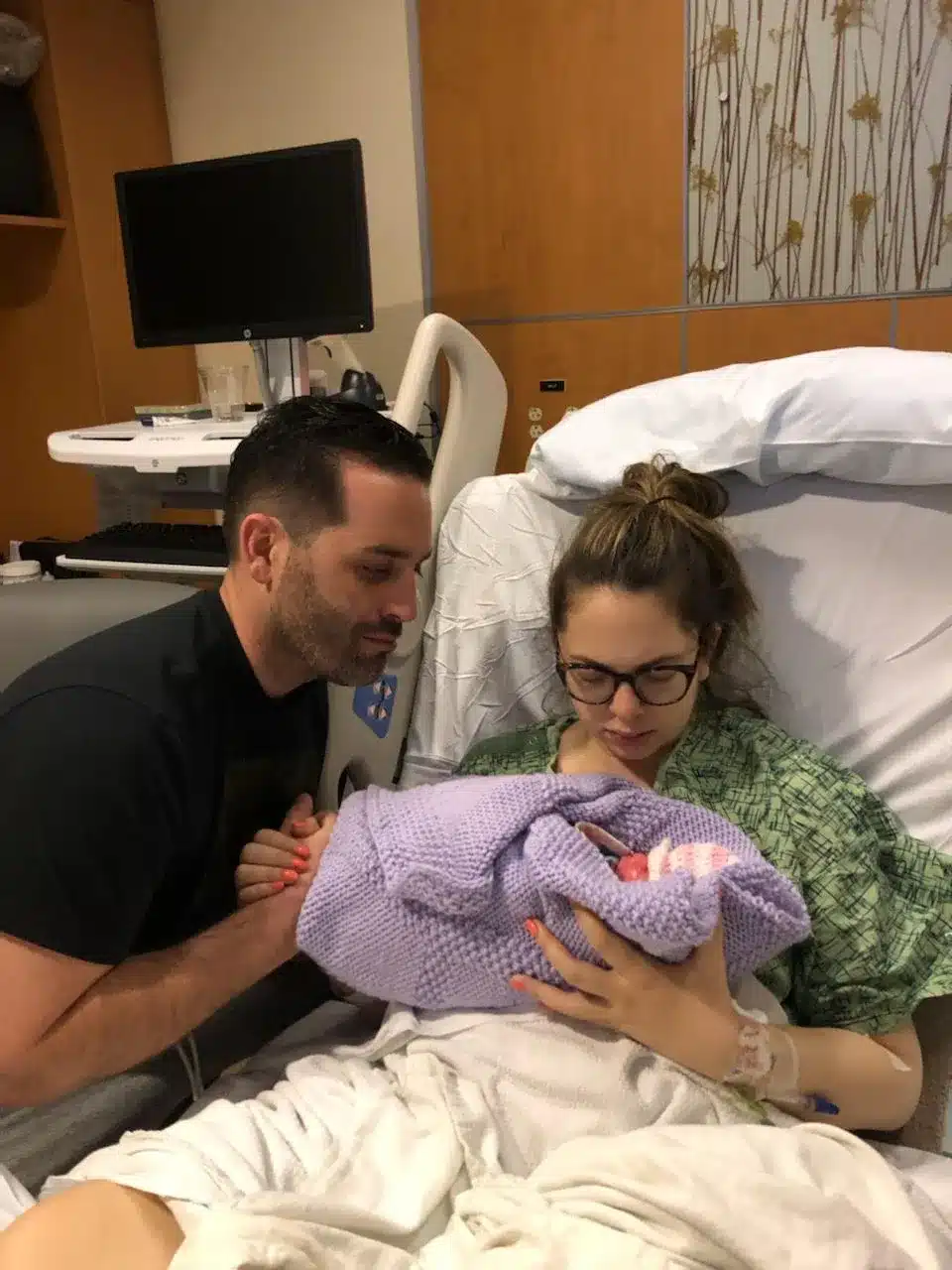Update 3/2/21: This blog post was published on Scary Mommy on 3/2/21!
Part of my work as a therapist is advocacy—I’m committed to shedding light on these very important topics that we just don’t talk enough about.
It’s an honor to have my story featured, and to have the opportunity to contribute to some major change that is needed within maternal mental health, and women’s health in general.
Click here to read this post on Scary Mommy.
I want my baby.
These are the words I silently repeat to myself when I tune out mid-conversation with friends or family. Typically, conversations about small life things like a stressful day at work, a hip new TV show, or a funny story that would usually incite laughter. Sometimes, the conversations are about bigger things—like a breakup, serious illness, or world event.
And always, regardless of the topic, the thoughts are the same; I want my baby. I want my baby. I want my baby.
My baby died on 3/3/2020—almost exactly a year ago. I was over 8-months pregnant with a newly purchased home, my dream job, and a partner who I knew after one meeting at age 19, would become my husband.
As the first anniversary of Addison’s delivery approaches, some things look different than this time last year; my body somewhat resembles what it used to (somewhat—because, you know, pregnancy), I’m back at work, and when asked by grocery store checkers how I am, I respond cheerfully, “I’m well, how are you?”
In a lot of ways, things look different—but in more ways, things are the same. I have difficulty sleeping, I cry every day (not all day every day, but at least some part of each day), and oftentimes, I find myself sitting in silence and shaking my head to myself, as my brain unpacks all that happened in a year’s time. But one thing is as strong today as it was then—the yearning for my baby who should be here and isn’t.
I remember when others seemed surprised after learning that she had passed away—surprised that I would need to go to the hospital to deliver her. I think people assume that when there is a loss, babies disappear, but this isn’t the case. Pregnancy does not vanish when the baby does not survive. Babies are delivered. They are delivered whether the loss occurs early in the pregnancy (sometimes vaginally at home, other times with medical intervention like surgery or medication), and they are delivered when there is a late term loss, typically by inducing labor (labor, as in the same thing you or your friend went through to bring home that healthy baby).
On 3/4/2020, I arrived at the women’s hospital for my scheduled induction. In the waiting room, I sat opposite excited, expectant mothers waiting to be checked in.
I will never get this experience back, I thought, as stuffed animals, balloons, and swollen bellies stared me stark in the face.
This will always be my first delivery—the delivery I imagined before I was ever married or seriously thought about having children of my own, though I never imagined it like this.
After checking in, they led me to my room, where I began to take in my surroundings. It was a large room with a private bathroom and appeared to be newly renovated.
Directly across from the bed, a baby warmer hugged the wall; its insides, gently lined with a baby blanket coated in colorful handprints. Not needing a constant, visual reminder of what was to come, I asked Daniel—my then 31-year-old husband who was once the 21-year-old boy I knew I’d marry, to please have it removed.
“They need a place to put her body,” he gently informed me, though they agreed to push the warmer closer to the door, out of my line of vision.
The nurse motioned me toward the bed, where a green-printed hospital gown was waiting, folded neatly. I grabbed the gown and headed to my private bathroom to change. As the baggy gown devoured my very-pregnant-but-still-petite-frame, I caught a final glimpse of my belly in the mirror.
Dressed in my chic new outfit, I waddled to the bed where I found a stack of intake papers waiting.
“You’re about to experience one of life’s most special joys,” the first form read. A grave mistake, considering the circumstances.
“Will you accept blood in the event a transfusion is needed?” a nurse asked, as I handed her the completed forms.
“Yes,” I said, thinking, I won’t need that; a red hospital band snapped on my right wrist.
It was just after 9PM when they began the induction, an induction which lasted a brutal 48 hours. During this time, a constant parade of family filtered through, with Daniel taking up permanent residence on a couch to the right of my bed—a couch that was two sizes too small for his tall and muscular build.
Multiple providers inserted hands, medication, and instruments deep into my body. My body fought hard and attempted to resist in defiance—as if to say, “no, please no”.
I want my baby. I want my baby.
But neither I, nor my body, had a say in the matter.
With a balloon for forced dilation and an amniotic hook which manually broke my water, active labor began.
Daniel held a plastic bag to my face and a cool washcloth to my forehead, as I laid in bed with a fever; sweating, shaking, and vomiting.
I felt pelvic pressure as the nurse placed my numb-from-the-epidural-limp-legs back in the stirrups. To my right, was Daniel, my hand, interlaced with his. I pushed only once and through tears, managed to find a voice lost, “Is it over?”
“That’s it, it’s over”. My doctor walked away with her body in his arms, still.
It was 8:53PM on 3/6/2020 and the silence was palpable.
Cleaned and bundled in a knit blanket with a pink hat resting delicately on her tiny head, she was handed to me. I held her snug in my arms, determined to soak up every detail—determined to know her; determined to love her—determined to mother her. I wanted to remember everything about her—how she looked, how she felt; I knew time with her was fleeting.
She was tiny at 4 lbs, 12 oz, and 17 ¾ inches. She had a darling nose and full lips. She was my baby—the one I grew inside of me for 8 months, the one I created with the person I love most in this world.
The medical team left to give the three of us time alone. We had 20-minutes of music, tears, and passing her back and forth, before Daniel began to panic.
“You’re bleeding a lot. I don’t think that’s normal”.
Daniel left to find help; I stayed in bed, holding her close.
With precision, the doctor quickly scrubbed in, my legs were back in stirrups, and my baby was taken from me.
I want my baby. I want my baby.
As the medical team began to assess the situation, I saw blood pour from my body; so much blood that the hospital linens were now red.
They vigorously ripped the plugs connecting the bed to the wall, and the 21-year-old boy, whom I loved instantly, planted a gentle kiss on my forehead. I heard his shaky, “I love you,” before they began wheeling me towards the operating room.
Once in the operating room, they positioned me flat on the table; approximately 8 medical professionals encircled my paralyzed body, still numb and motionless from the waist down.
They pulled a strap over my upper body to prevent movement, confining me to the table.
With no anesthesia to take me away, I remained that way, utterly cognizant, as they worked furiously to stop the bleeding.
With 4 ports for simultaneous blood transfusions, I laid there, helpless.
“If we can’t stop the bleeding, we will need to do a hysterectomy,” someone said.
I’m 29. My baby died. I’m going to die. If I live, I’m going to be infertile. My thoughts were loud, but I didn’t feel scared or nervous; I felt calm.
I was dissociating as my survival instincts kicked in. I was being traumatized. My brain was doing exactly what it was designed to do, to help me survive.
I heard my voice stuck on repeat, playing the same questions in a monotone voice, “Am I going to die? Am I going to be infertile?
“We’re doing everything we can for you,” they tried to comfort me by rubbing my left arm.
When they realized they couldn’t stop the bleeding, I was transferred to another hospital on the same campus, via some underground tunnel.
I arrived in a new operating room with a new team of medical professionals and a fancy imaging machine to assist with the procedure.
In this procedure there was much more silence, no rubbing of the arm, a one-time offering of verbal reassurance. They finished the procedure, and I was transferred to the ICU at around 3AM.
Once reunited with my husband, I asked the question, “Where’s my baby?” I want my baby.
I was told I could see her again when stable and transferred to the acute unit.
The next day, approximately 15 hours after delivery, I was reunited with her. We tried to make up for time that was lost, time that will never be restored.
The social worker dropped off a memory box filled with mementos from my little; locks of hair, footprints, a molded handprint, and pictures—pictures taken I presume immediately after her birth. But the only pictures I have holding her are from the following day.
As the year anniversary approaches, it’s still hard to process and understand everything that has happened. A collection of moments has forever changed my world, and the person I am in it.
Since losing my daughter, my work as a therapist has changed. I have dedicated a portion of my practice to working with other women and families who have experienced loss and trauma. Something many (and even myself) often refer to as post traumatic growth.
Post traumatic growth is beautiful, powerful, and real. It is beautiful, AND it doesn’t undo the pain, trauma, and grief. If given the choice to provide therapeutic support to fellow loss mamas or have my baby, it’s a choice I wouldn’t need to think about, because my answer will always remain the same. I will always choose her, I will always miss her, and I will always want her, hence, the replaying of that set of 4 words; I want my baby.
These are the 4 words I think throughout the day, the 4 words I share aloud to friends, family, and my therapists (both my couples and individual therapists), the words that no matter when or how I say them, always bring me to tears. Every now and then I like to mix it up with a good-old-fashion, “I feel sad,” which also easily does the trick.
Daniel has his own set of words too, his, equally simple and profound—“I miss our baby”.
So, as I get ready to bookend a year that can’t really be put into words or writing, I stick with what I know:
I want my baby. I miss my baby. I love my baby.
And always will.
For perinatal resources, click here.
For grief resources, click here.
Written by Tracy Gilmour-Nimoy, M.S., LMFT, PMH-C


